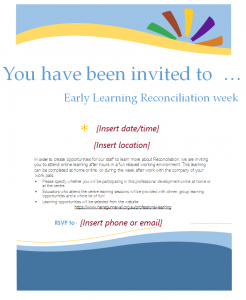10 Organising a professional learning event
Harriet McCarron
An example invitation:

A curriculum which reflects the realities of a racially and culturally diverse student body is perhaps more likely to create an environment with the potential to appeal to a more diversified teaching force. For this purpose the resource is an event invitation focusing on educators’ professional development for Reconciliation to encourage understanding and ability to diversify teaching. Lacking the capacity to replace staff, an out-of-work hours learning event allows staff to access the recommended reconciliation professional development in a group setting or home on their own. This flexibility encourages staff to pursue professional development opportunities in an environment that appeals directly to the individual learning style (group learning setting or individual learning setting). The invitation is linked to Narragunnawali (https://www.narragunnawali.org.au/) professional learning resources that build staff awareness and understanding of Aboriginal and Torres Strait Islander histories, cultures, and contributions, and supports the implementation of reconciliation initiatives. Providing the link to staff through an invitation enables staff to navigate their way through the website before making a choice to be involved in the event in the workplace after hours or at home. Staff may be provided dinner at the Centre to encourage the group learning setting. However, this is not a mandatory event.
Australian Indigenous cultures and languages should be promoted and explored in all early learning contexts, whether there are Aboriginal or Torres Strait Islander students or not. Quality teaching for Aboriginal and Torres Strait Islander students requires educators to have knowledge and sensitivity towards children’s histories, cultures and languages (AITSL, 2017). By providing opportunities for staff to educate themselves on this topic, it ensures that they can obtain relevant information to embed in their learning programs.
This event alleviates the pressure of management having to restaff and fund a daytime professional development. Making time to connect is what the resource is suggesting educators do, creating a weeklong event (see invitation for details) to complete learning that will benefit them as future educators (Berchini, 2015). If professional development took place during the day, the management would have to source staff that the children had relationships with and would be comfortable which may be difficult in a multicultural learning environment (Berchini, 2015). They would also be required to find a space to hold the professional development which would most likely only be possible to run for one day. The event allows the staff to make a choice to attend their workplace after hours with relaxed learning opportunities that will allow them to incorporate their understanding of reconciliation in the learning environment.
Links
Early Years Learning Framework (DEEWR, 2009)
- Outcome 2: Children are connected with and contribute to their world
- 2.2 Children respond to diversity with respect
Queensland Kindergarten Learning Guideline (QCAA, 2018)
- Identity: building a sense of security and trust
- Conectedness: Showing respect for diversity
National Quality Standard (ACECQA, 2018)
- Quality Area 1: Educational program and practice
- 1.1.3 Program learning opportunities: All aspects of the program, including routines, are organised in ways that maximise opportunities for each child’s learning.
- 1.2.1 Intentional teaching: Educators are deliberate, purposeful, and thoughtful in their decisions and actions
- Quality Area 4: Staffing arrangements
- 4.2.1 Professional collaboration: Management, educators and staff work with mutual respect and collaboratively, and challenge and learn from each other, recognising each other’s strengths and skills.
- Quality Area 7: Governance and leadership
- 7.2.1 Continuous improvement: There is an effective self-assessment and quality improvement process in place.
- 7.2.3 Development of professionals: Educators, co-ordinators and staff members’ performance is regularly evaluated and individual plans are in place to support learning and development.

